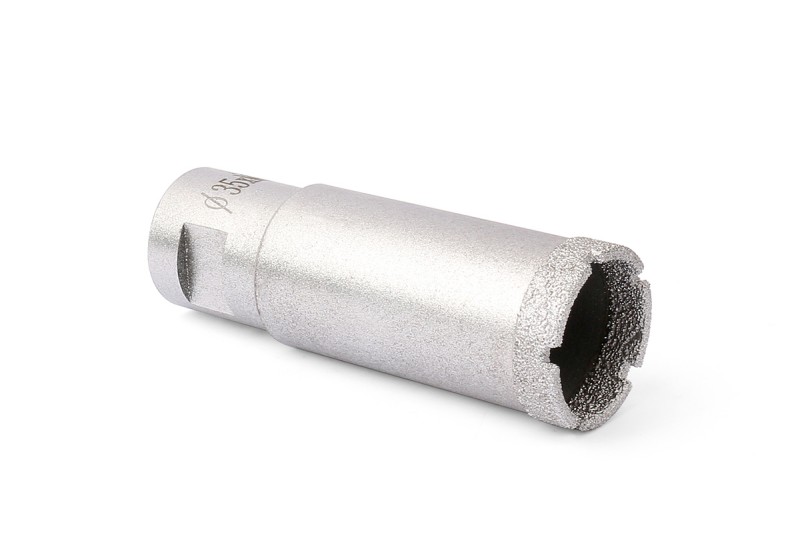
Detailed Explanation of the Manufacturing Process of Brazed Diamond Drill Bits
Brazed diamond drill bits are widely recognized for their exceptional performance in drilling hard materials, making them a popular choice for industries as diverse as construction, mining, and stone processing. The manufacturing process for brazed diamond drill bits involves several key steps to ensure the end product is durable, efficient, and able to withstand demanding applications.

Brazed Diamond Drill Bit Manufacturing Process
1. Material selection
The first step in the manufacturing process is to carefully select the materials. This mainly involves two aspects:
Diamond grain: The diamonds used must possess specific characteristics to ensure optimal performance. They should be hard, wear-resistant, corrosion-resistant, and thermally stable. The quality of the diamonds directly affects the cutting efficiency and service life of the drill bit.
Matrix material: The matrix acts as a binder, holding the diamond particles in place. It must possess excellent bonding properties to securely attach the diamonds while ensuring the necessary structural integrity. Common matrix materials include various metal alloys capable of withstanding high temperatures and mechanical stress.
2. Pre-brazing treatment
Before starting the brazing process, both the diamond particles and the matrix material undergo a pre-brazing treatment to ensure a strong bond.
Cleaning: Thoroughly clean the surfaces of the diamond particles and the matrix to remove any contaminants that may interfere with the brazing process. This step is critical to achieving a reliable bond.
Brass fluid application: The brazing fluid is then sprayed onto the cleaned surface. The brazing fluid aids the bonding process by promoting the flow of the brazing material during heating.
Drying: The treated components are baked until dry, ensuring that the brazing fluid adheres properly to the surface before the brazing process begins.
3. Brazing
The brazing process is the core of the manufacturing process, during which the diamond particles are firmly bonded to the substrate.
Heating: The diamond and substrate assembly is placed in a brazing furnace and the temperature is gradually increased. The specific temperature depends on the type of brazing alloy used, but is typically between 800°C and 1000°C.
Liquidation of brazing fluid: As the temperature increases, the brazing fluid becomes liquid. The liquid flows into the spaces between the diamond particles and the matrix, ensuring complete coverage.
Bonding: High temperatures melt the brazing filler metal and create a metallurgical bond between the diamond particles and the matrix. This process creates a strong and durable connection that is crucial to the performance of the drill bit.
4. Cutting and shaping
Once the brazing process is complete and the assembly has cooled, the brazed diamond drill bit is ready for cutting and shaping.
Cutting: Use precision cutting tools to cut the drill bit to the desired length and diameter. This step ensures that the drill bit meets the specific size requirements of various applications.
Fine polishing: After cutting, the drill bit is finely polished to obtain a smooth surface. This polishing process reduces friction during drilling and improves cutting accuracy, thereby enhancing the performance of the drill bit.
5. Calcination and curing
The final step in the manufacturing process is calcination and curing, which solidifies the structure of the brazed diamond drill bit.
Oven heating: The drill bit is placed in a drying oven and heated to a specific temperature. This step helps solidify the brazed structure, ensuring that the diamond is firmly bonded to the substrate.
Increased hardness: The heating process also increases the hardness of the matrix material, enhancing the overall durability of the drill bit.
Reduced internal stress: Curing helps relieve any internal stress that may have developed during the brazing and cutting process, further improving the stability and performance of the drill bit.
Performance and Application of Brazed Diamond Drill Bits
1. High hardness
Diamond is one of the hardest substances known to mankind, which makes brazed diamond drill bits extremely hard and wear-resistant. This property makes them particularly suitable for drilling hard materials such as:
Concrete: Ideal for construction projects requiring precise drilling of concrete structures.
Stone: Suitable for quarrying and stone fabrication where durability is of paramount importance.
Ceramics: Capable of drilling through tough ceramic materials used in a variety of applications.
2. Good thermal stability
The brazing process used to manufacture these drill bits is crucial to maintaining the thermal stability of the diamond. By precisely controlling the brazing temperature, manufacturers can prevent the diamond particles from rheological changes, oxidation, or thermal cracking. This ensures:
Long life: Drill bits maintain their performance over a longer period of time, reducing the need for frequent replacement.
Consistent performance: The stability of the diamond structure contributes to reliable drilling results even in high temperature environments.
3. Wide range of applications
Brazed diamond drill bits are a versatile tool used across a variety of industries, including:
Geological exploration: Used for core sampling and geological surveys, these drill bits can penetrate hard rock formations to extract valuable geological data.
Oil Extraction: In the oil and gas industry, brazed diamond drill bits are used to drill through hard geological formations to access oil reserves.
Rock mining: These drill bits are crucial to mining operations, effectively cutting through hard rock to facilitate the extraction of minerals.
Construction: Widely used in construction to drill into concrete, brick and masonry to provide precise holes for anchors and accessories.
Manufacturing: Used in various manufacturing processes that require precision drilling, such as producing parts for machinery and tools.
4. Accuracy
Brazed diamond drill bits are manufactured with high precision, enabling precise drilling and a smooth surface finish. This precision is crucial in applications where tight tolerances are critical and hole quality is paramount. Benefits of this precision include:
Reduce material waste: Precision drilling minimizes the need for rework and reduces material waste, helping to save costs.
Improved product quality: The smooth surface achieved through precise drilling improves the overall quality of the final product, whether in construction or manufacturing.
In Conclusion
The manufacturing process for brazed diamond drill bits requires meticulous attention to detail at every stage, from material selection to final curing. By utilizing high-quality diamond grit and matrix materials, combined with precise brazing techniques, manufacturers are able to produce drill bits that deliver exceptional performance, durability, and efficiency. As the demand for high-performance tools continues to grow across a wide range of industries, brazed diamond drill bits will remain an essential part of the toolboxes of professionals across all sectors.
-
Online service
-
Official wechat
account
-
QQ:40933769
-
E-mail:
sales@z-lion.com
Online service
Please feel free to give your inquiry in the form below. We will reply you in 24 hours.

